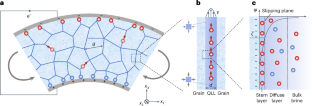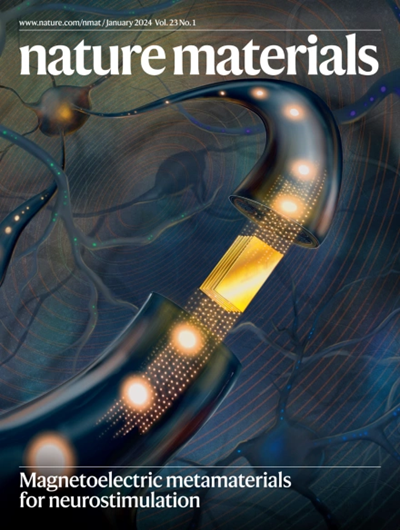Streaming flexoelectricity in saline ice
IF 38.5
1区 材料科学
Q1 CHEMISTRY, PHYSICAL
引用次数: 0
Abstract
Despite 10% of the Earth’s surface being covered by ice, ice power remains untapped. Although ice is known to generate electricity upon bending via flexoelectricity1, the generated electric polarization per curvature, that is, the flexoelectric coefficient, is too small (~1–10 nC m−1) to be utilized for electromechanical devices. Here we demonstrate that doping ice with NaCl can enhance its flexoelectric coefficient 1,000-fold, to ~1–10 μC m−1. We find that this enhancement is due to the bending-induced streaming current along ice grain boundaries. On the basis of this mechanism, we fabricated flexural devices with an effective piezoelectric coefficient of ~4,000 pC N−1, which is comparable to that of the best piezoelectric materials. The high flexoelectricity of saline ice brings the vision of harnessing ice power one step closer to reality, and may also be relevant to the electrical activity of ice-covered terrestrial regions and icy ocean worlds such as Europa or Enceladus. In addition, the model for coupling between strain gradients and streaming currents is not limited to ice and provides a general framework for extracting electromechanical activity from liquid-infused porous solids. By doping ice with NaCl, it is shown that a flexoelectric coefficient of up to 10 μC m−1 is generated, enabling effective piezoelectric coefficients that are comparable to those of ceramics. This arises from the streaming current of quasi-liquid flow through grain boundaries from one side of the sample to the other.


在盐水冰中流动的柔性电流
尽管地球表面的10%被冰覆盖,但冰能仍未被开发。虽然已知冰在弯曲时通过挠曲电产生电1,但每曲率产生的电极化,即挠曲电系数,太小(~1 - 10 nC m−1),无法用于机电设备。研究表明,在冰中掺入NaCl可以使其挠曲电系数提高1000倍,达到~1 ~ 10 μC m−1。我们发现这种增强是由于沿冰晶边界的弯曲流电流引起的。在此基础上,我们制作了有效压电系数为~4,000 pC N−1的弯曲器件,与最好的压电材料相当。盐水冰的高弹性电使利用冰能的愿景更接近现实,并且可能与冰覆盖的陆地区域和冰海洋世界(如木卫二或土卫二)的电活动有关。此外,应变梯度和流动电流之间的耦合模型不仅限于冰,而且为从注入液体的多孔固体中提取机电活动提供了一个总体框架。
本文章由计算机程序翻译,如有差异,请以英文原文为准。
求助全文
约1分钟内获得全文
求助全文
来源期刊

Nature Materials
工程技术-材料科学:综合
CiteScore
62.20
自引率
0.70%
发文量
221
审稿时长
3.2 months
期刊介绍:
Nature Materials is a monthly multi-disciplinary journal aimed at bringing together cutting-edge research across the entire spectrum of materials science and engineering. It covers all applied and fundamental aspects of the synthesis/processing, structure/composition, properties, and performance of materials. The journal recognizes that materials research has an increasing impact on classical disciplines such as physics, chemistry, and biology.
Additionally, Nature Materials provides a forum for the development of a common identity among materials scientists and encourages interdisciplinary collaboration. It takes an integrated and balanced approach to all areas of materials research, fostering the exchange of ideas between scientists involved in different disciplines.
Nature Materials is an invaluable resource for scientists in academia and industry who are active in discovering and developing materials and materials-related concepts. It offers engaging and informative papers of exceptional significance and quality, with the aim of influencing the development of society in the future.
 求助内容:
求助内容: 应助结果提醒方式:
应助结果提醒方式:


